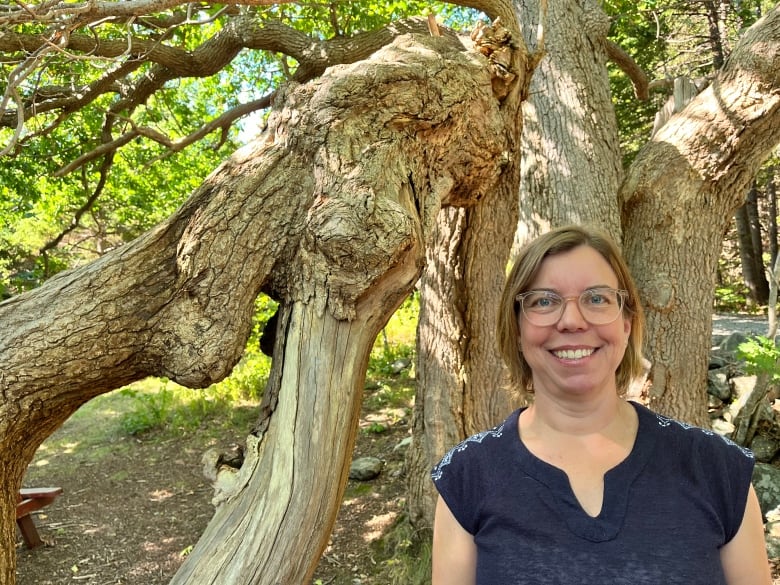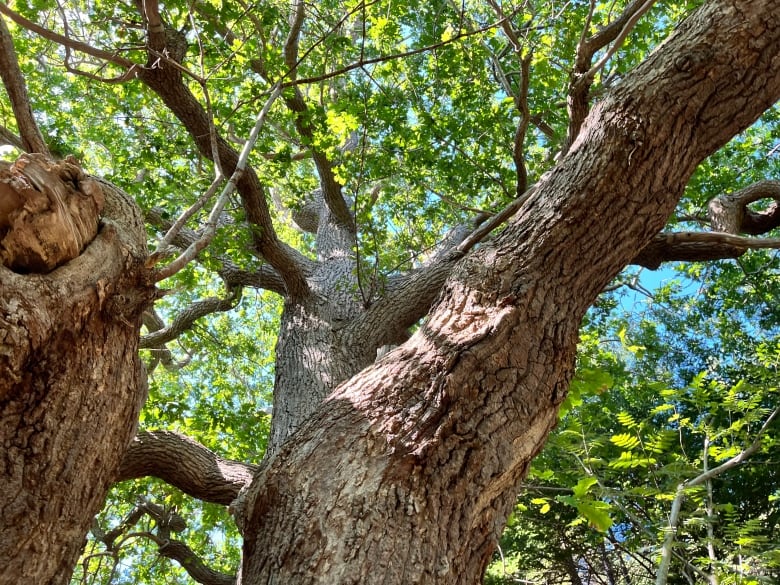What can a tree tell us? Prof says trees reveal stories of the past, present and future
Every tree carries history within its roots and branches, Memorial researcher says

Although trees can't talk, they do have a lot to say, says Memorial University professor Carissa Brown.
"Trees actually give us a real history of the place that they're growing," Brown said in an interview.
Brown isa biogeographerand a forest ecologist, and says looking at a tree's exterior and interior gives insightinto what happened to it, about the ground it's rooted in, and about the environmental conditions around it.
Brown showed how one single tree an oak tree growing along a trail not far from the Health Sciences Centre in St. John's can tell quite a story.
It has three trunks connected underground, its branches spiraling and stretching toward the sky, each branch hairy with leaves.
Onechunk of the tree is resting it almost looks defeated on the ground, a sign that something as strong as a hurricane must have passed its path, Brown saisd.
But the rest of the tree, like its main trunk, is healthy and thick, telling passersby that not only is it doing fine, it's thriving.
But the oak tree is not native to Newfoundland, Brown said.
Oak trees are native to mainland Canada, she said. They grow from acorns, whichare too heavy to be carried from the mainland to the island naturally from the wind or birds. So, this oak tree was planted by someonelong ago.
"What this tree tells us is that oak trees could do really well here if the seed was able to get here," Brown said.
The collection of stories from trees were part of a free lecture Brown gave earlier this weekcalled Stories Trees Tell Us.
She saidother ways people can listen to the history of a tree is by looking inside into its rings. Each ring represent not only time,but it also reveals how the world around the tree treated it.
A ring that is wide and healthy means the treereceived enough moisture and nutrients from the environment at a certain time. A thin ring could mean the opposite. Burn marks could signal there was a forest fire, while ripped pieces, like the mighty oak tree has, could mean there was a weather event in the area, like a hurricane.
Trees tell a story even if many years have passed since they started to grow.
Brown said scientists can look at wood planks from old structures, like a shipwreck, and look at the ring patterns for clues of their origins. The rings are matched to a database, which is collected by scientists around the world, to help give the piecea date in history. Then, judging by the species of tree used, they can learn wherethe ship was built.
"That simple act of looking at those tree rings and those patterns of growth can tell us about human actions in the past."

Trees tell the story of theirenvironment
Similar to the oak tree, othertrees thatsignal they are doing well are black spruce trees. They are abundant on Newfoundland, because they can grow in the "worst conditions," she said, where the soil is poor in nutrients and the hard salty wind hits them. Other trees, like yellow birch and red maple grow in soil that has more nutrients.
"That tells us that those areas are a bit more productive they're better places to grow," she said. "The west coast of the island has, kind of, the most biodiversity of trees."
Thisinformation is useful, she said, because as the climate changes, communities can look into what trees can thrive in the next decades and plant them.

Communities can take the signs from trees to know which are best to plant.
"We can certainly think about what species we find now on the island might do better in the future. And those are the kinds of species that are adapted to warmer temperatures," Brown said.
"I can imagine in central Newfoundland, if we start to get hotter, drier, longer summers, that we might start to see that those coniferous forests that have more drought stress start to perhaps decline and not grow as much."
Trees are an an important part of the province's ecosystem, she said. They produce oxygen, give shade, are a home to various animals and insects, and help take up carbon.
"They also just provide a lot of enjoyment for folks," she said, suggesting that people become more curious about their silent neighbours.
"Go for a stroll really start to look at the trees and think about what those trees might be telling. Why are those species of trees growing in that place? How long have they been there? How did they get there and what that might tell us about our environment?"
Download ourfree CBC News appto sign up for push alerts for CBC Newfoundland and Labrador.Click here to visit our landing page.














_(720p).jpg)


 OFFICIAL HD MUSIC VIDEO.jpg)
.jpg)



























































































